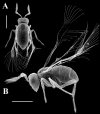Hymenoptera and biomimetic surfaces: insights and innovations
- PMID: 39530025
- PMCID: PMC11552452
- DOI: 10.3762/bjnano.15.107
Hymenoptera and biomimetic surfaces: insights and innovations
Abstract
The extraordinary adaptations that Hymenoptera (sawflies, wasps, ants, and bees) exhibit on their body surfaces has long intrigued biologists. These adaptations, which enabled the immense success of these insects in a wide range of environments and habitats, include an amazing array of specialized structures facilitating attachment, penetration of substrates, production of sound, perception of volatiles, and delivery of venoms, among others. These morphological features offer valuable insights for biomimetic and bioinspired technological advancements. Here, we explore the biomimetic potential of hymenopteran body surfaces. We highlight recent advancements and outline potential strategic pathways, evaluating their current functions and applications while suggesting promising avenues for further investigations. By studying these fascinating and biologically diverse insects, researchers could develop innovative materials and devices that replicate the efficiency and functionality of insect body structures, driving progress in medical technology, robotics, environmental monitoring, and beyond.
Keywords: arthropods; bio-inspired surfaces; bioengineering; cuticle; nanoscale structures.
Copyright © 2024, Lopez et al.
Conflict of interest statement
There are no conflicts to declare.
Figures








References
-
- Gorb S N. Insect-Inspired Technologies: Insects as a Source for Biomimetics. In: Vilcinskas A, editor. Insect Biotechnology. Dordrecht, Netherlands: Springer Netherlands; 2011. pp. 241–264. - DOI
-
- Gorb S N, Gorb E V. Aquatic Insects as a Source for Biomimetics. In: Del-Claro K, Guillermo R, editors. Aquatic Insects: Behavior and Ecology. Cham, Switzerland: Springer International Publishing; 2019. pp. 401–426. - DOI
